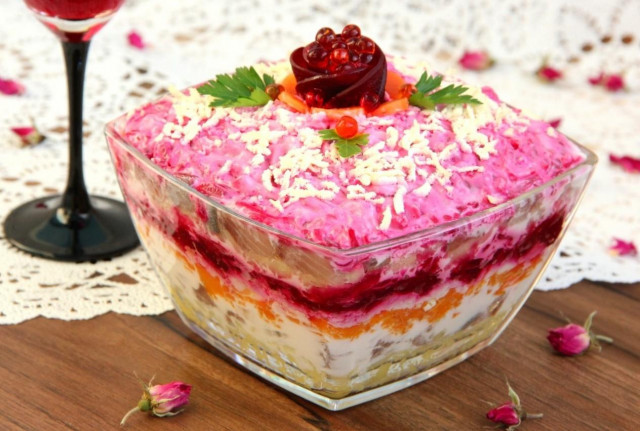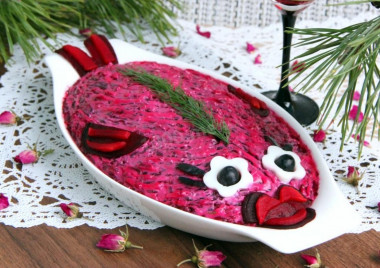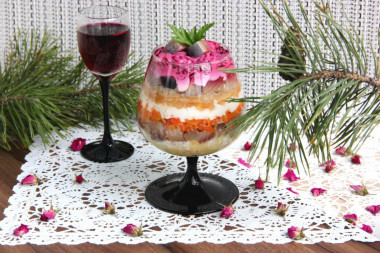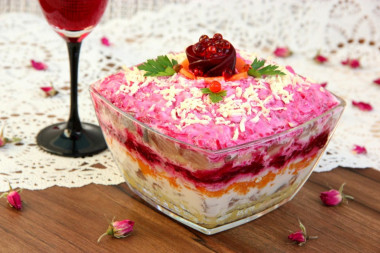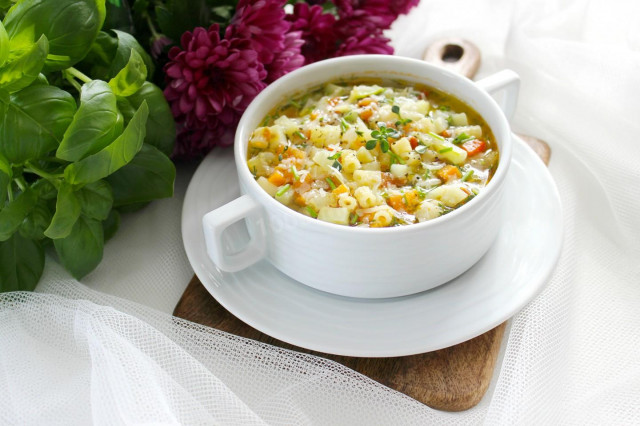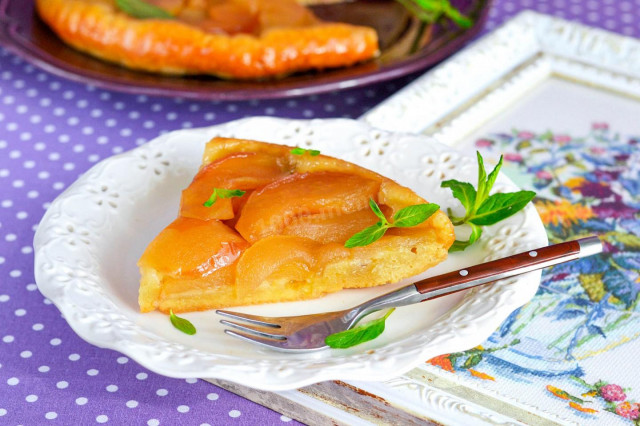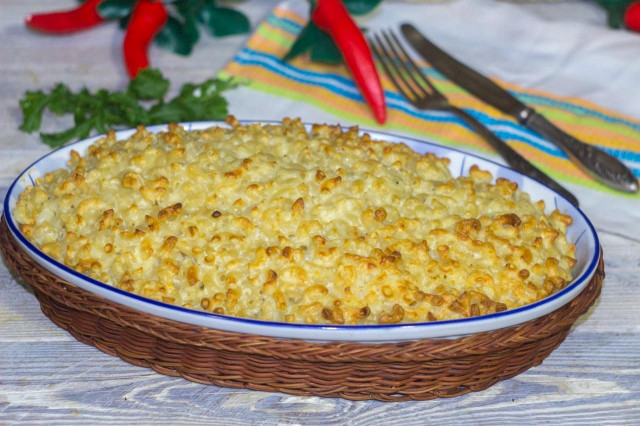Composition / ingredients
Step-by-step cooking
Step 1:
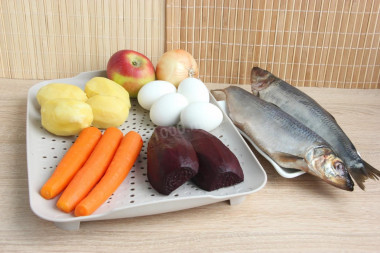
How to make a classic herring under a fur coat with an apple? Prepare the products, pay special attention to the choice of herring. You can also take the finished fillet, but it loses in taste, although it saves time. Boil the eggs hard-boiled for 8-9 minutes, immediately pour cold water, it will be so easy to peel the shell.
Step 2:

Boil carrots, beets, potatoes in a convenient way in advance, they will need to be cooled down. You can cook vegetables in a uniform, I prefer to pre-peel, so I like the taste more. And it is better to boil for a couple, without digesting. In a slow cooker, I cook carrots for 15 minutes, potatoes for 20, beets for 25. If I boil it in a steamer, I put beets on the lower tray, potatoes on the middle tray, carrots on the upper tray, I set a timer for 30 minutes, I take it out when ready.
Step 3:
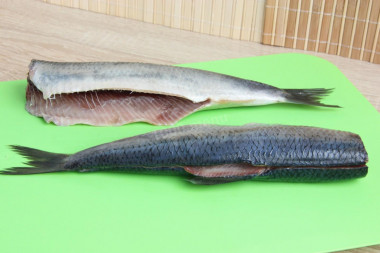
How to cut fish into fillets? Cut off the head from the carcass. Retreating from the caudal fin, cut 0.5 cm deep into the abdomen. Clean the insides, rinse the fish under cool water, well remove the remnants of the film from the abdomen. Dry with a towel and make a shallow incision along the back, cutting the fin from both sides, also along the abdomen to the tail.
Step 4:
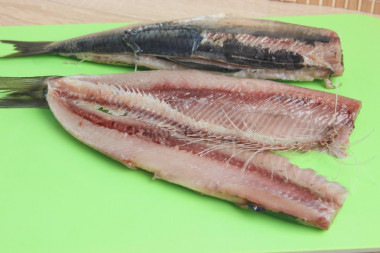
Remove the upper and tail fins. Gently pick up and remove the skin, it is more convenient for me to do it from the head. Then remove the ridge - run your thumb along the incision of the back, using the tip of the knife to help release the large bones, then easily pull the ridge, it will easily separate from the carcass. Carefully remove all the bones, preferably with tweezers.
Step 5:
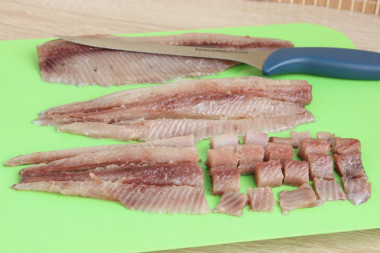
Cut the resulting fillet first lengthwise into strips, then crosswise into pieces that are convenient for you. So the remaining bones will be clearly visible, which are easy to remove even with your hands.
Step 6:
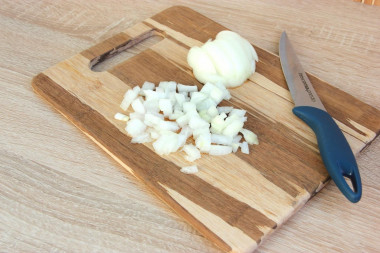
Cut onion into small cubes. If the onion is very sharp, you can pour boiling water over it to remove excess bitterness. Sometimes onions are pickled or lightly fried. I like fresh, I choose juicy, sweet varieties.
Step 7:

If you cook in a large salad bowl, grate the vegetables on a coarse grater directly into the salad bowl, so the salad will have a more delicate taste. If a serving is supposed to be served in a small bowl, it is more convenient to rub all the vegetables in separate bowls, then collect them, alternating layers. The first layer we have is potatoes. Put it on the bottom of the salad bowl.
Step 8:

2nd layer - herring, 3rd - onion. I do not lubricate the first two layers with mayonnaise.
Step 9:

And here is the third layer, onion, smear with mayonnaise.
Step 10:
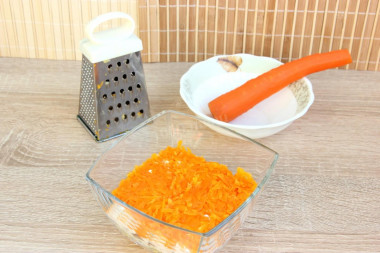
There is a 4th layer on the onion - carrots.
Step 11:
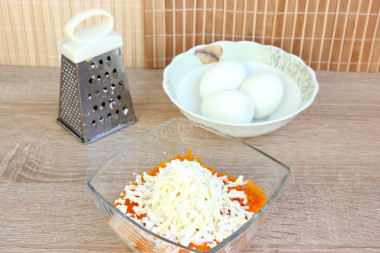
Then the 5th layer - boiled whites with yolks. To do this, grate the eggs on a grater.
Step 12:

6th layer - apple. You can take any, even sweet, even sour. Do not forget to cut the peel from the apple.
Step 13:
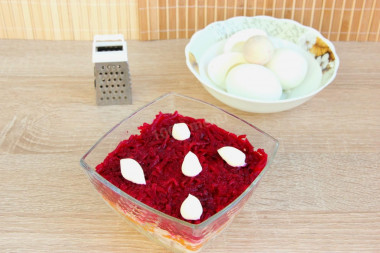
The 7th layer is beetroot, which is then smeared with mayonnaise. If your salad bowl is high, repeat all the layers. But the top layer will always be beetroot and mayonnaise. Carefully level the layers. When all the layers are laid out in a salad bowl (choose their thickness yourself), cover the dishes with cling film and put them in the refrigerator for impregnation for 1-2 hours, preferably overnight. Before serving, you can rub the boiled yolk on top, sprinkle with herbs.
Step 14:

The ways of serving and decorating can be different. I got one large or several medium salad bowls. It's good when the walls are transparent, then all the layers are beautifully and appetitiously visible.
Step 15:
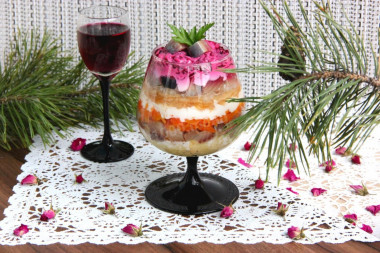
When serving portions in wine glasses or cremans, the layers are also effectively visible. This is not a classic "fur coat", so you can improvise with layers as you like!
Step 16:
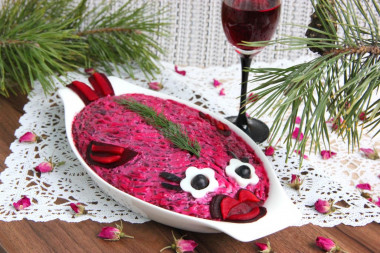
When served on a platter or in a herring bowl, it is better to arrange a salad in the form of a funny fish, children love this kind of serving and even the "unloved" beetroot is eaten with pleasure! Bon appetit and happy holidays!
The first presentation of the salad took place on the eve of the 1919 New Year! The author of the salad is considered to be the merchant Anastas Bogomilov / owner of the largest Moscow - Tver network of taverns and canteens/.But it was invented by the cook Aristarchus Prokoptsev. The salad was served as a cold appetizer to alcohol, which contributed to less intoxication and rampage of visitors, and therefore it instantly became the most popular dish at every feast in the turbulent post-revolutionary time and to the present day.
The dish will turn out to be more airy if you rub the vegetables directly into the salad bowl, and not into separate bowls. The taste of the finished dish largely depends on the taste of the herring itself, so it is better to buy not a ready-made fillet, namely a herring. How to choose it correctly?
1) Look at the gills: dark red / means fresh /.
2) The eyes are red - salty / it will be greasy/.
3) Cloudy eyes - caviar / she is not fat, because she moved a lot during spawning/.
4) Mouth - round, small - female
- narrow, elongated - male / they taste better.
5) When pressing on the body - it must be elastic.
6) If there are black or red streaks on the surface, the fish did not lie in brine for a long time, and this is bad.
If the onion is bitter, it is better to scald it with boiling water, you can pickle it. Beets should be chosen with a maroon, sweeter and more tender pulp. And take starch potatoes, crumbly varieties.
Following these recommendations, we will get a delicate, amazing-tasting salad.
I propose an option on the theme of a classic salad. Such a salad in my family is asked to cook for every New Year and I must say - I am not tired, it is due to additives that I constantly change. I can add red fish, pickled cucumber, prunes, cheese, caviar.. And of course serving and decoration, in the form of cake, roll, with gelatin.. The taste will be different every time, but so recognizable and beloved! I specify the time taking into account the preparation of vegetables and impregnation in the refrigerator.
Salad can be prepared in advance, which is important on a holiday, its taste will only benefit.
It is better to prepare mayonnaise yourself. It will be tastier and healthier. See here interesting
recipes for homemade mayonnaise.
Also, as a dressing, you can use not only mayonnaise, but also sour cream or natural yogurt. They can be taken separately or mixed with mayonnaise in any proportion to your taste - this will reduce the calorie content of the dish.
Caloric content of the products possible in the composition of the dish
- Ripe potatoes - 80 kcal/100g
- Baked potatoes - 70 kcal/100g
- Mashed potatoes - 380 kcal/100g
- Boiled potatoes - 82 kcal/100g
- Potatoes in uniform - 74 kcal/100g
- Fried potatoes - 192 kcal/100g
- Chicken egg - 157 kcal/100g
- Egg white - 45 kcal/100g
- Egg powder - 542 kcal/100g
- Egg yolk - 352 kcal/100g
- Ostrich egg - 118 kcal/100g
- Apples - 47 kcal/100g
- Dried apples - 210 kcal/100g
- Canned apple mousse - 61 kcal/100g
- Beetroot - 40 kcal/100g
- Dried beetroot - 278 kcal/100g
- Boiled beets - 49 kcal/100g
- Carrots - 33 kcal/100g
- Dried carrots - 275 kcal/100g
- Boiled carrots - 25 kcal/100g
- Herring in vegetable oil - 301 kcal/100g
- Herring in sour cream - 97 kcal/100g
- Herring in tomato sauce - 159 kcal/100g
- Hot smoked herring - 215 kcal/100g
- Pickled herring - 192 kcal/100g
- Fresh herring - 161 kcal/100g
- Salted herring - 217 kcal/100g
- Salad mayonnaise of 50% fat content - 502 kcal/100g
- Light mayonnaise - 260 kcal/100g
- Provencal Mayonnaise - 624 kcal/100g
- Provencal mayonnaise - 627 kcal/100g
- Table mayonnaise - 627 kcal/100g
- Onion - 41 kcal/100g

